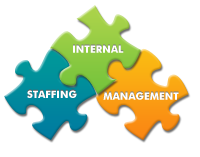Letting Loose the Power of Data: Enhancing HR Techniques With Cutting-Edge Staffing Monitoring Software
By taking advantage of the power of information analytics, companies can not just boost their employment methods but likewise enhance staff member retention and efficiency. The synergy between data-driven understandings and progressed modern technology offers a compelling possibility for Human resources specialists to change their technique towards talent administration.
Value of Data-Driven Human Resources Approaches
Data-driven Human resources strategies make it possible for firms to maximize their labor force administration, employment procedures, and staff member interaction efforts. By examining information associated to worker performance, turnover rates, and skill voids, Human resources departments can determine trends, anticipate future demands, and establish proactive solutions to resolve obstacles.
Data-driven human resources techniques likewise play a critical function in improving employee complete satisfaction and retention. Through the evaluation of staff member feedback, performance reviews, and training results, human resources experts can tailor private development strategies, acknowledge high-potential employees, and promote a culture of continuous discovering and development within the organization. Furthermore, data-driven insights allow human resources groups to align their techniques with the overall organization purposes, making sure that talent monitoring initiatives directly add to organizational success.
Benefits of Staffing Management Software
Using staffing management software improves the recruitment and onboarding processes for HR divisions, boosting performance and precision in talent acquisition. One considerable advantage of this software application is the capability to streamline prospect data, making it quickly available for employment groups. By having all candidate details in one place, HR experts can effectively track candidate development, interact properly with possible hires, and guarantee a seamless employment experience.
In addition, staffing management software program usually consists of attributes such as return to analyzing and keyword matching, which aid in promptly determining leading prospects that match the task needs. This automation decreases the time invested in hands-on return to evaluating, allowing HR personnel to concentrate on even more calculated jobs. staffing management software. Furthermore, these systems can incorporate with work boards and social media platforms, expanding the reach of job posts and bring in a diverse pool of prospects
Furthermore, analytics and reporting tools within staffing monitoring software offer important understandings into employment metrics, such as time-to-fill and cost-per-hire. This data-driven approach makes it possible for human resources teams to make informed decisions, enhance employment approaches, and enhance general working with processes. By leveraging these advantages, companies can improve their talent procurement efforts, boost candidate experience, and inevitably construct a strong workforce.
Enhancing Employment Procedures With Information
By leveraging information, firms can make more enlightened decisions throughout the employment lifecycle, ultimately leading to much better hires and improved retention prices. One key means data improves employment processes is by enhancing work posts based on insights from past successful hires.
Furthermore, data analytics can streamline the testing and option procedure by determining patterns in prospect credentials and performance signs. This allows recruiters to focus their efforts on prospects that are probably to do well check out this site in the function, saving time and sources. Furthermore, data-driven employment approaches can aid reduce bias in the working with procedure by giving objective insights right into candidate qualifications and potential fit within the company. On the whole, integrating data into recruitment processes encourages organizations to make smarter employing choices and build high-performing groups.
Improving Staff Member Retention With Modern Technology

One way technology can improve employee retention is via making use of worker involvement platforms. These systems enable real-time feedback, recognition, and communication in between staff members and management, promoting a society of appreciation and support. In addition, innovation can make it possible for individualized knowing and advancement programs tailored to private employee needs and occupation goals, enhancing work fulfillment and commitment.
In addition, data analytics devices can help organizations determine fads and patterns connected to staff member turn over, enabling them to take proactive measures to attend to possible concerns prior to they escalate. Generally, by leveraging innovation efficiently, organizations can create a more encouraging and engaging workplace that encourages workers to remain and grow within the company.
Making The Most Of Workforce Efficiency With Information

Through the evaluation of information, human resources departments can recognize patterns and trends that impact efficiency levels. By tracking worker job hours and task completion prices, companies can optimize job schedules to ensure that jobs are successfully dispersed amongst group participants. In addition, information can reveal ability spaces within the workforce, permitting human resources to execute targeted training programs that improve staff member abilities and total productivity.
Additionally, data-driven performance evaluations enable managers to provide particular responses and assistance to workers, cultivating a society of constant enhancement. In general, leveraging information to make best use of workforce performance is a calculated strategy that equips organizations to attain their objectives properly and successfully.
Verdict
Finally, utilizing advanced staffing management software can significantly enhance HR approaches by leveraging the power of information. By including data-driven employment processes, boosting staff member retention with technology, and taking full advantage of workforce productivity, organizations can improve their procedures, make more informed choices, and ultimately attain better success in handling their human resources. Welcoming these technological developments is crucial in the ever-evolving landscape of human source administration.
Data-driven HR strategies make it possible for business to maximize their workforce monitoring, employment processes, and employee interaction initiatives. By evaluating data associated to employee performance, turn over prices, and skill gaps, Human resources departments can identify patterns, anticipate future requirements, and develop positive remedies to resolve obstacles.
